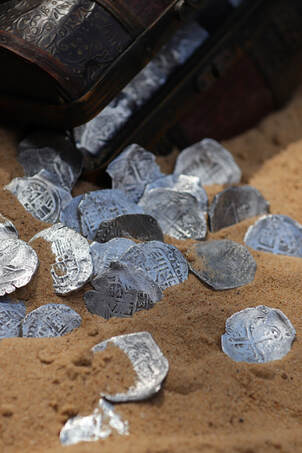Southland Coins & Collectibles Inc.
4670 Lake Street
Treasure Coins
Spanish 8 Reals or Spanish Dollars
|
There are two major denominations of Spanish colonials: reales for silver coins and escudos for gold coins. Many of us are familiar with stories of pirate treasure of gold doubloons and pieces of eight. The escudos are the gold doubloons, and the reales are the silver pieces. The Real de a Ocho, also known as the Spanish dollar, the Eight Royals Coin, or the Piece of Eight, is a silver coin of approximately 38 mm diameter that was minted in the Spanish Empire after 1598. Its purpose was to correspond to the German thaler.
The Spanish dollar coin was worth eight reales and could be physically cut into eight pieces, or "bits," to make change — hence the colloquial name "pieces of eight." It became the first world currency by the late 18th century because of its wide use in Europe, the Americas, and the Far East. The American dollar used today was based on the Spanish dollar, and remained legal tender in the United States until the Coinage Act of 1857. Though they have been out of use for over one hundred years, pieces of eight have a lasting legacy. Terminology related to them was used to refer to certain portions of a dollar in the United States even in the 20th century; for example, a quarter was known as "two bits," and 50 and 75 cents were "four bits" and "six bits" respectively. The New York Stock Exchange listed stock prices in one-eighths of a dollar until 1997. |
NGC Certified 8 Reales from Spice Islands Wreck, circa 1630 - $395.00
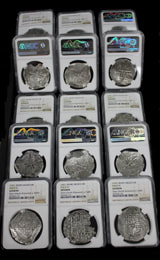
The Spice Islands are a small group of islands to the northeast of Indonesia, between Celebes and New Guinea. The remains of an unknown vessel, perhaps a merchant or pirate ship, were discovered and contained several chests of 8 reales. The 8 reales were minted in the New World mints of Mexico City, Mexico, and Potosi, Bolivia, during the reign of Philip IV of Spain.
The Real de a Ocho, also known as the Spanish dollar, the Eight Royals Coin, or the Piece of Eight, is a silver coin of approximately 38 mm diameter that was minted in the Spanish Empire after 1598. Its purpose was to correspond to the German thaler. The Spanish dollar coin was worth eight reales and could be physically cut into eight pieces, or "bits," to make change — hence the colloquial name "pieces of eight."
These coins have been certified as genuine by the National Guaranty Corporation and are professionally preserved to maximize their historic beauty after having spent almost 400 years on the ocean floor. Click on the image to see a larger representation of the coins.
The Real de a Ocho, also known as the Spanish dollar, the Eight Royals Coin, or the Piece of Eight, is a silver coin of approximately 38 mm diameter that was minted in the Spanish Empire after 1598. Its purpose was to correspond to the German thaler. The Spanish dollar coin was worth eight reales and could be physically cut into eight pieces, or "bits," to make change — hence the colloquial name "pieces of eight."
These coins have been certified as genuine by the National Guaranty Corporation and are professionally preserved to maximize their historic beauty after having spent almost 400 years on the ocean floor. Click on the image to see a larger representation of the coins.
8 Real Coin from Spice Islands Shipwreck - $795.00
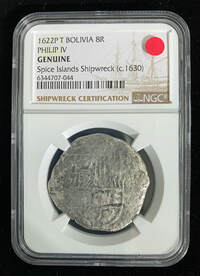
This coin was part of a Spice Islands Shipwreck discovery and has been certified by NGC as genuine. It was minted in 1622 in Potosi, Bolivia, during the reign of Philip IV. Philip IV (April 8, 1605-September 17, 1665) also called the Planet King, was King of Spain from 1621 until his death and and King of Portugal from 1621-1640 (as Philip III). Philip is remembered for his patronage of the arts, including such artists as Diego Velazquez and his rule over Spain during the Thirty Years' War.
The coin is extremely rare as part of the date (22) is visible on the reverse.
Click on the image to view a larger representation of the coin's obverse and reverse.
The coin is extremely rare as part of the date (22) is visible on the reverse.
Click on the image to view a larger representation of the coin's obverse and reverse.
SS Republic Treasure Coins
The SS Republic was a Civil War-era sidewheel steamship that sank in 1865 while carrying a large cargo of silver and gold coins and a stunning variety of everyday wares essential to life in mid-19th century America. It was discovered by Odyssey Marine Exploration in 2003.
En route from New York to New Orleans with passengers and commercial cargo, the SS Republic was lost in a violent hurricane on October 25, 1865. The passengers and crew escaped from the sinking ship, yet a fortune in coins and much needed cargo to help rebuild New Orleans' post-Civil War economy sank to the bottom of the Atlantic seabed 1,700 feet (518 meters) deep. Nearly 140 years later, Odyssey discovered the shipwreck of the Republic approximately 100 miles off the Georgia coast.
The SS Republic was originally christened the SS Tennessee and served in both the Confederate and Union navies during the Civil War, including a stint as Admiral David Farragut's flagship. She fought vigorously in several conflicts, including the Battle of Mobile Bay, made famous by Farragut's exclamation, "Damn the torpedoes--full speed ahead!"
The two coins below were part of the discovery. Each coin on this page has been certified by the Numismatic Guaranty Corporation (NGC) and is encapsulated with a special label.
En route from New York to New Orleans with passengers and commercial cargo, the SS Republic was lost in a violent hurricane on October 25, 1865. The passengers and crew escaped from the sinking ship, yet a fortune in coins and much needed cargo to help rebuild New Orleans' post-Civil War economy sank to the bottom of the Atlantic seabed 1,700 feet (518 meters) deep. Nearly 140 years later, Odyssey discovered the shipwreck of the Republic approximately 100 miles off the Georgia coast.
The SS Republic was originally christened the SS Tennessee and served in both the Confederate and Union navies during the Civil War, including a stint as Admiral David Farragut's flagship. She fought vigorously in several conflicts, including the Battle of Mobile Bay, made famous by Farragut's exclamation, "Damn the torpedoes--full speed ahead!"
The two coins below were part of the discovery. Each coin on this page has been certified by the Numismatic Guaranty Corporation (NGC) and is encapsulated with a special label.
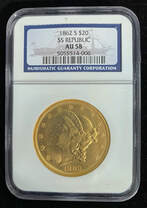
This 1862 S $20 Gold piece was minted in San Francisco and has been been graded AU and certified by NGC. Only 12 coins are graded higher by NGC.
The coin sells for $9,150.00.
Click on the image to view a larger representation of the coin.
The coin sells for $9,150.00.
Click on the image to view a larger representation of the coin.
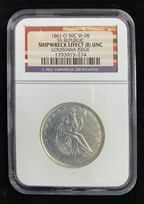
This 1861 O Standing LIberty Half Dollar was minted in New Orleans. The W-08 is one of 14 different die marriages for three governments, the United States, Louisiana, and Confederate governments. This particular coin was minted under the Louisiana government, which only lasted from January 26, 1861, and kept its independent status until March 21, 1861, when it joined the Confederate States of America. The coin has been authenticated by NGC.
The coin is graded UNC and sells for $750.00.
Click on the image to view a larger representation of the coin.
The coin is graded UNC and sells for $750.00.
Click on the image to view a larger representation of the coin.
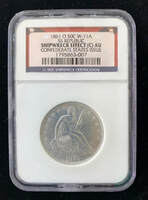
After the New Orleans Mint operated under the Confederate States of American, a few coins issued by the Confederates were merely the continuation of regular-issue federal coinage. For example, the New Orleans Mint was commandeered by rebels after Louisiana seceded from the Union in January 1861. The New Orleans Mint was deemed the most well-equipped minting facility in the South and subsequently was dubbed the Confederate States Mint. Yet, even under Confederate occupation, federally hired mint employees were permitted to remain in their positions and produce United States coinage using Union dies. Differentiating between the three producers is virtually impossible but with one exception. During usage to create coins for the CSA, the obverse cracked from the rim to the nose of Liberty. The die remained in use by the Confederates to produce additional halves and serves as an indication of strikes made under the orders of the CSA.
The coin is graded AU and sells for $1,250. Click on the image to view a larger representation of the coin.
The coin is graded AU and sells for $1,250. Click on the image to view a larger representation of the coin.
4 Real Coin - $1,495.00

This coin was minted between 1556-98 in Seville, Spain, during the reign of Philip II. Philip II (May 21, 1527 – September 13, 1598), also known as Philip the Prudent, was King of Spain from 1556, King of Portugal from 1580, and King of Naples and Sicily from 1554 until his death in 1598. He was jure uxoris (a title because his wife held the title) King of England and Ireland from his marriage to Queen Mary I in 1554 until her death in 1558.
The son of Emperor Charles V and Isabella of Portugal, Philip inherited his father's Spanish Empire in 1556 and succeeded to the Portuguese throne in 1580 following a dynastic crisis. The Spanish conquests of the Incan empire and of the Philippines, named in his honor, were completed during his reign. Under Philip II, Spain reached the height of its influence and power, sometimes called the Spanish Golden Age, and ruled territories in every continent then known to Europeans.
The coin is certified by NGC and is graded AU 58. Click on the image to view a larger representation of the coin's obverse and reverse.
The son of Emperor Charles V and Isabella of Portugal, Philip inherited his father's Spanish Empire in 1556 and succeeded to the Portuguese throne in 1580 following a dynastic crisis. The Spanish conquests of the Incan empire and of the Philippines, named in his honor, were completed during his reign. Under Philip II, Spain reached the height of its influence and power, sometimes called the Spanish Golden Age, and ruled territories in every continent then known to Europeans.
The coin is certified by NGC and is graded AU 58. Click on the image to view a larger representation of the coin's obverse and reverse.
2 Real Coin - $3,995.00
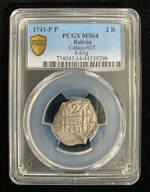
This 2 real coin was issued during the reign of Philip V, whose father was the eldest son of Louis XIV of France and Maria Theresa of Spain. Maria Theresa’s half-brother was King Charles II of Spain. Since King Charles II was childless, his will named Philip as his successor. When Charles died in 1700, Philip became King of Spain and ruled until 1724, when he abdicated the throne in favor of his son, Louis. Louis only reigned for seven months and died from smallpox. Philip become king again and ruled until 1746. His reign was the longest in the history of the Spanish monarchy.
The obverse of the coin shows the Jerusalem cross, and the reverse has 2 columns with 3-digits of the date (741) and value (2) between them. The P designates that it was minted in Potosi, Bolivia, and the second P indicates the assayer.
With the discovery of Cerro Rico, considered the richest source of silver in history, the present-day city of Potosí was born. It began as a mining settlement established by the Spaniards on 1 April 1545, dependent on the city of La Plata (now Sucre). The amazing extraction of silver led to its rapid growth and by 1560 it had a population of 50,000. On 21 November 1561 it achieved city status and independence from the city of La Plata. The expansion of trade, the unexpected boom of the city and the unsealed silver in circulation, among other factors, created the need to organize a coinage center. According to the books of the Royal Treasury of Potosí, the first silver coinage minted at the mint began on 28 March 1574, using the rudimentary technique of hammer minting. From 1617 onwards, the last three digits of the year of minting were added to the inscriptions on the coins as a way of improving the control that existed with the mint mark and the initial of the assayer responsible for the fine-tuning of the silver used.
The coin is certified by PCGS and is graded MS64. Click on the image to view a larger representation of the coin's obverse and reverse.
The obverse of the coin shows the Jerusalem cross, and the reverse has 2 columns with 3-digits of the date (741) and value (2) between them. The P designates that it was minted in Potosi, Bolivia, and the second P indicates the assayer.
With the discovery of Cerro Rico, considered the richest source of silver in history, the present-day city of Potosí was born. It began as a mining settlement established by the Spaniards on 1 April 1545, dependent on the city of La Plata (now Sucre). The amazing extraction of silver led to its rapid growth and by 1560 it had a population of 50,000. On 21 November 1561 it achieved city status and independence from the city of La Plata. The expansion of trade, the unexpected boom of the city and the unsealed silver in circulation, among other factors, created the need to organize a coinage center. According to the books of the Royal Treasury of Potosí, the first silver coinage minted at the mint began on 28 March 1574, using the rudimentary technique of hammer minting. From 1617 onwards, the last three digits of the year of minting were added to the inscriptions on the coins as a way of improving the control that existed with the mint mark and the initial of the assayer responsible for the fine-tuning of the silver used.
The coin is certified by PCGS and is graded MS64. Click on the image to view a larger representation of the coin's obverse and reverse.

